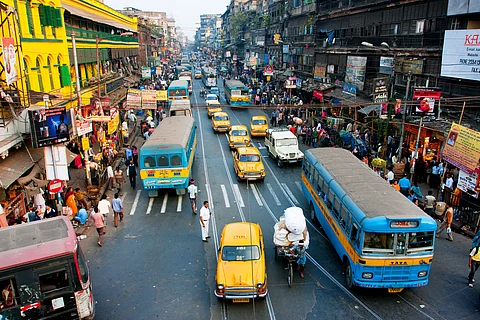

Commuting to work in India looks vastly different depending on which state you were in. In Tamil Nadu and Kerala, the public bus was key. In Uttar Pradesh and Odisha, bicycles kept millions moving. And in much of Maharashtra, walking remained the norm, reflecting sharp divides in mobility access across the country.
Walking remained the most common mode of commuting to work over short distances — between 0 and 10 kilometres — in Maharashtra, followed by Uttar Pradesh and West Bengal, according to Census 2011 data.
In Maharashtra, nearly five million people walked to work daily. Uttar Pradesh and West Bengal followed with just over four million and 3.8 million people, respectively.
While walking dominated short-distance travel for work, census data revealed that buses were the preferred mode of transport for longer commutes — particularly those exceeding 10 kilometres.
For distances between 11 and 20 kilometres, Tamil Nadu reported the highest number of bus commuters, with close to one million people using public buses to travel to work. Karnataka and Kerala followed, with 0.5 million and 0.4 million commuters, respectively.
After buses, bicycles emerged as the second-most popular choice for commuting within the 11-20 kilometre range. Uttar Pradesh recorded the highest bicycle usage in this category, with around 0.4 million people cycling to work. In fact, in several states such as Uttar Pradesh, Odisha and Tamil Nadu, more people used bicycles than buses over these distances.
However, a closer look at the data revealed that the most popular mode of transport across different distance brackets — 0-1, 2-5, 6-10, 11-20, 21-30, 31-50 and over 50 kilometres — did not always hold uniformly across all states.
For work commutes between 21 and 30 kilometres, buses attracted the highest ridership nationally, with Tamil Nadu again leading the figures at around 0.43 million people. But this trend varied by state — Kerala, Gujarat and Punjab, for instance, showed a stronger preference for bicycles over buses.
Such divergences continued across different categories for distances between home and workplace. While buses generally dominated long-distance commutes in many states, West Bengal stood out for its high reliance on trains for journeys over 50 kilometres — suggesting a more robust railway infrastructure compared to bus services. Maharashtra and Kerala also showed a similar pattern, with more people commuting by train than by bus over these distances.
In total, walking remained the most used mode of travel to work, with over 20 million people out of the 200 million surveyed relying on foot commutes. However, it was largely confined to shorter distances.
Following walking, bicycles accounted for 13 per cent of all commutes — amounting to over 26 million users — while motorised vehicles (such as scooters, motorbikes and cars) served around 24 million people.
Interestingly, 30 per cent of the surveyed population — over 60 million people — reported no travel to work at all, indicating the presence of home-based employment or informal labour practices and highlighting the complexity of India’s commuting landscape.
This article is part of our series on how India moves, which looks at the relationship between air quality and human mobility in cities and towns.